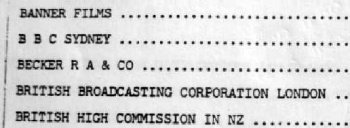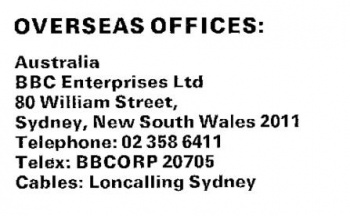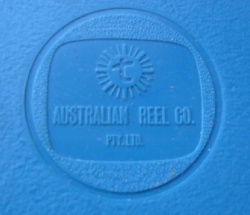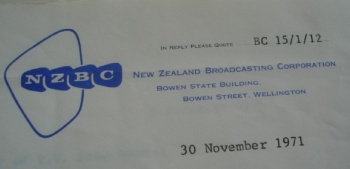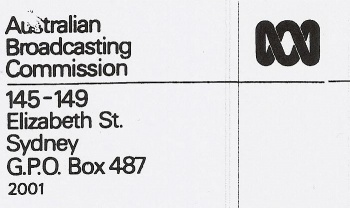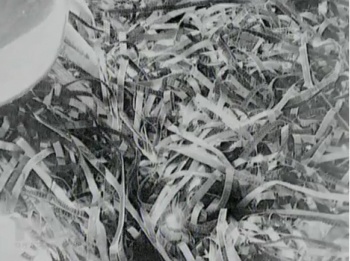Difference between revisions of "BBC Sydney"
Jon Preddle (talk | contribs) |
Jon Preddle (talk | contribs) |
||
| Line 29: | Line 29: | ||
For that purpose, BBC Enterprises in London would send to BBC Sydney a set of 16mm film positive prints or fine-grain positives from which further copies could be made locally, if, as and when required. Another source of "Audition Prints" was other foreign broadcasters, who would be instructed to send to another country a couple of the prints they had already aired. | For that purpose, BBC Enterprises in London would send to BBC Sydney a set of 16mm film positive prints or fine-grain positives from which further copies could be made locally, if, as and when required. Another source of "Audition Prints" was other foreign broadcasters, who would be instructed to send to another country a couple of the prints they had already aired. | ||
| − | Once a foreign broadcaster had committed to a purchase, BBC Sydney handled the contracts and other paperwork, and also assisted in arranging supply of the film prints and tapes. These copies either came from BBC in London, or were bicycled in from other broadcasters. <!--On occasion, BBC Sydney would provide copies themselves, making dupes from the audition samples they held. BBC Sydney used local film labs and facilities to duplicate film prints or to make video tape dupes.--> | + | Once a foreign broadcaster had committed to a purchase, BBC Sydney handled the contracts and other paperwork, and also assisted in arranging supply of the film prints and tapes. These copies either came from BBC in London, or were bicycled in from other broadcasters. <!--On occasion, BBC Sydney would provide copies themselves, making dupes from the audition samples they held. BBC Sydney used local film labs and facilities to duplicate film prints or to make video tape dupes.--> |
[[File:AusReelCo.JPG|right|thumb|250px|Example of Australian Reel Co Pty Ltd 'stamp' on a plastic film can]] | [[File:AusReelCo.JPG|right|thumb|250px|Example of Australian Reel Co Pty Ltd 'stamp' on a plastic film can]] | ||
| Line 66: | Line 66: | ||
However, a handful of ex-ABC films are known to have been bicycled elsewhere. A set of 17 William Hartnell episodes on 16mm film that had previously been used by the ABC (some of these films had been cut by the Australian censors) were sent to [[New Zealand]] in mid-1967; that run of stories spanned [[The Reign of Terror]] to [[The Rescue]]. | However, a handful of ex-ABC films are known to have been bicycled elsewhere. A set of 17 William Hartnell episodes on 16mm film that had previously been used by the ABC (some of these films had been cut by the Australian censors) were sent to [[New Zealand]] in mid-1967; that run of stories spanned [[The Reign of Terror]] to [[The Rescue]]. | ||
| − | Ex-ABC prints from [[The Chase]], [[The War Machines]] and [[The Faceless Ones]] that had been junked were acquired by a film collector, and subsequently returned to the BBC in the 1980s. | + | Ex-ABC prints from [[The Chase]], [[The War Machines]] and [[The Faceless Ones]] that had been junked were acquired by a film collector circa 1970, and subsequently returned to the BBC in the 1980s. Of note, those same episodes of [[The Chase]] and [[The Faceless Ones]] were also returned to the BBC in London in 1975. (Did the ABC have two prints of certain episodes because one of them had been mislaid or damaged at some point?) |
| − | + | ||
A batch of ex-ABC Troughton stories sent back to BBC Enterprises in London (including [[The Dominators]], which had been cut by the Australian censors), were recovered in the late 1970s. Two further ex-ABC prints, [[Galaxy 4]] part three, and [[The Underwater Menace]] part two, were returned by a UK film collector in 2011. | A batch of ex-ABC Troughton stories sent back to BBC Enterprises in London (including [[The Dominators]], which had been cut by the Australian censors), were recovered in the late 1970s. Two further ex-ABC prints, [[Galaxy 4]] part three, and [[The Underwater Menace]] part two, were returned by a UK film collector in 2011. | ||
| − | + | All films acquired by the ABC were held at the Federal Film Library and Bond Store, before screening and returned to afterwards. It was at this facility that [[The Celestial Toymaker]] part four was recovered in 1984. (See the profile on that serial for more thoughts on the origin of that particular 'missing' print.) | |
Revision as of 00:53, 13 September 2015
BBC ENTERPRISES LIMITED, SYDNEY
The BBC has many broadcast customers around the world. With an industry "Quota" to be met, the BBC's first priority was selling to other Commonwealth countries. With hundreds of Commonwealth (and non-Commonwealth) broadcasters all requiring product but operating in different time-zones across the globe, the BBC had to out-source some of its sales and distribution processes to those better-suited and capable of handling sales locally.
It therefore made sense for the BBC to have a presence elsewhere, other than just in London, where sales could continue to be made around the world while the London office was 'asleep'. The BBC therefore established offices in Toronto, Canada; and Sydney, Australia, to handle sales to countries in those areas.
The BBC also struck up a relationship with Time Life Films (later Time Life Television) in the United States to handle distribution within the United States, Latin America (specifically in Central America and South America). Time Life's contract expired in March 1981; after that date the BBC's new partner and distributor was Lionheart Television International Inc, of which the BBC bought full ownership in early 1986. From the Lionheart offices in the US, the BBC sold copies of the US/NTSC tapes to other countries around the world, such as Saudi Arabia.
Sales to countries in the Caribbean, Africa and Middle East were often facilitated by Television International Enterprises Ltd's subsidiary, TIE (Programmes) Limited.
While BBC Toronto dealt exclusively with the many networked and private broadcasters in Canada, BBC Sydney was directly responsible for selling BBC product to countries in South East Asia, specifically Australia, New Zealand, Singapore, Malaysia, Brunei, and Hong Kong (and possibly also Thailand, Sri Lanka, Taiwan, Korea (South), Japan, and Bangladesh).
This page deals exclusively with what was known as "BBC Sydney".
SYDNEY SALES
The basic sales process was this:
BBC Sydney would send sales literature (such as brochures, synopsis sheets) promoting the programmes (dramas, comedies, documentaries, plays, etc) they had on offer to existing and potential customers.
Customers would often want to preview a programme before they made a firm commitment to purchase, so BBC Sydney would send them "Audition Prints" (aka Viewing Prints).
For that purpose, BBC Enterprises in London would send to BBC Sydney a set of 16mm film positive prints or fine-grain positives from which further copies could be made locally, if, as and when required. Another source of "Audition Prints" was other foreign broadcasters, who would be instructed to send to another country a couple of the prints they had already aired.
Once a foreign broadcaster had committed to a purchase, BBC Sydney handled the contracts and other paperwork, and also assisted in arranging supply of the film prints and tapes. These copies either came from BBC in London, or were bicycled in from other broadcasters.
It is understood that many of the prints that were supplied to New Zealand from 1968/1969 and up to the early 1970s were sent from London to the Sydney office, where they were placed into film cans before being despatched to the NZBC. (The surviving film can for The Moonbase episode three bears two manufacturer's markings: "Australian Reel Co" and "Australian Made", confirming at least the origin of the film can!)
It's likely that the BBC in London would regularly ship a large consignment of films to their offices in Sydney for bundling into cans and shipping to the relevant countries; that was probably a quicker – and far cheaper! - option than London transporting sets of films to each country separately.
From late 1964 onwards, BBC Sydney (potentially) may have had in its possession at one time or another copies of all Doctor Who episodes on 16mm film or (from 1973 onwards) PAL video tape.
In the case of local sales, BBC Sydney would also liaise with the Australian Film Censorship Board (AFCB), who was responsible for viewing and classifying all television programming in Australia.
EASY AS ABC
Two of the BBC's biggest customers were in Australia and New Zealand. While Australia had many network and private TV stations operating across the country, New Zealand had - until 1989 - just one television company, the NZBC (later named TVNZ).
Of the Australian broadcasters, the non-commercial ABC (Australian Broadcasting Commission / Corporation) was the single biggest purchaser of BBC programmes in the world. The ABC operated a base station in each of the eight states / territories, which meant that films had to be regularly transported across the country. Sometimes multiple copies of the same episode existed, enabling different regions to air the same programme on the same day.
The BBC valued the ABC as a customer, and as such, the ABC often had first refusal to purchase all BBC material ahead of the other Australian networks. But this meant that the ABC paid a hefty price for this privilege, usually paying (in pre-decimal currency days) thousands of pounds for each episode, whereas other countries – such as New Zealand – paid only hundreds.
The high prices paid by the ABC also contributed towards much of the needed revenue required to pay contributor royalties per union requirements (Actors' Equity, Musicians' Union, Writers' Guild), meaning Australia funded up front almost all the rights clearance fees needed to be paid by Commonwealth countries, which meant that other Commonwealth countries did not have to pay any further fees. (The single biggest draw-back to this arrangement was that should a programme or episode be rejected or not go to air (due to censorship ratings, for instance) another country could not afford to buy that programme or episode. This is why those Doctor Who stories that were not seen in Australia between 1966 and 1974 (such as Mission to the Unknown, The Daleks' Master Plan, Inferno, The Mind of Evil, The Daemons, and The Green Death) were also not seen by any other Commonwealth country.)
The ABC did not commence colour broadcasts until March 1975. However, for at least two years in advance of this date, the ABC acquired colour copies of some programmes, which were placed into storage to await scheduling after colour was launched.
In some cases, these colour tape copies were the only ones in existence, since the colour tape masters held by Enterprises in London had already been wiped, since many of the countries that Enterprises in London dealt with were still broadcasting in black and white. (This is why the colour tapes of Frontier in Space were eventually recovered from Australia in the early 1980s.)
FINAL DESTINATION
After they had passed their "use-by-date", the films and tapes used by Australian broadcasters were usually destroyed. The "Audition Prints" held by BBC Sydney were also disposed of in due course.
However, a handful of ex-ABC films are known to have been bicycled elsewhere. A set of 17 William Hartnell episodes on 16mm film that had previously been used by the ABC (some of these films had been cut by the Australian censors) were sent to New Zealand in mid-1967; that run of stories spanned The Reign of Terror to The Rescue.
Ex-ABC prints from The Chase, The War Machines and The Faceless Ones that had been junked were acquired by a film collector circa 1970, and subsequently returned to the BBC in the 1980s. Of note, those same episodes of The Chase and The Faceless Ones were also returned to the BBC in London in 1975. (Did the ABC have two prints of certain episodes because one of them had been mislaid or damaged at some point?)
A batch of ex-ABC Troughton stories sent back to BBC Enterprises in London (including The Dominators, which had been cut by the Australian censors), were recovered in the late 1970s. Two further ex-ABC prints, Galaxy 4 part three, and The Underwater Menace part two, were returned by a UK film collector in 2011.
All films acquired by the ABC were held at the Federal Film Library and Bond Store, before screening and returned to afterwards. It was at this facility that The Celestial Toymaker part four was recovered in 1984. (See the profile on that serial for more thoughts on the origin of that particular 'missing' print.)
BBC WORLDWIDE
BBC Sydney is now part of BBC Worldwide, and their office is located in Macquarie Park, New South Wales.
Links

